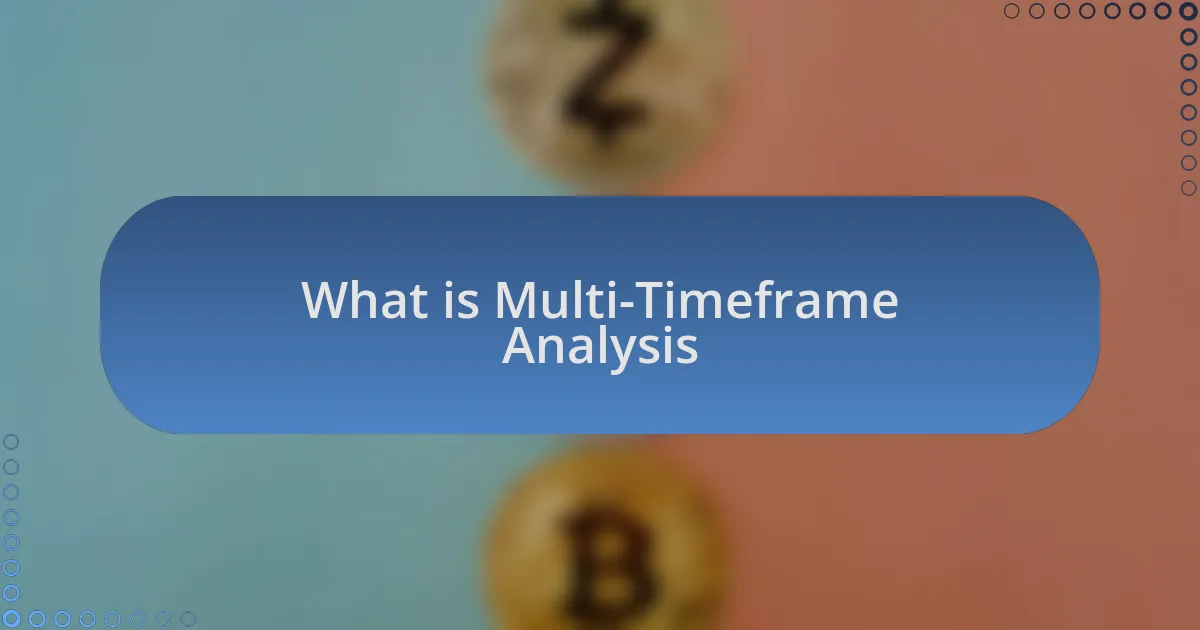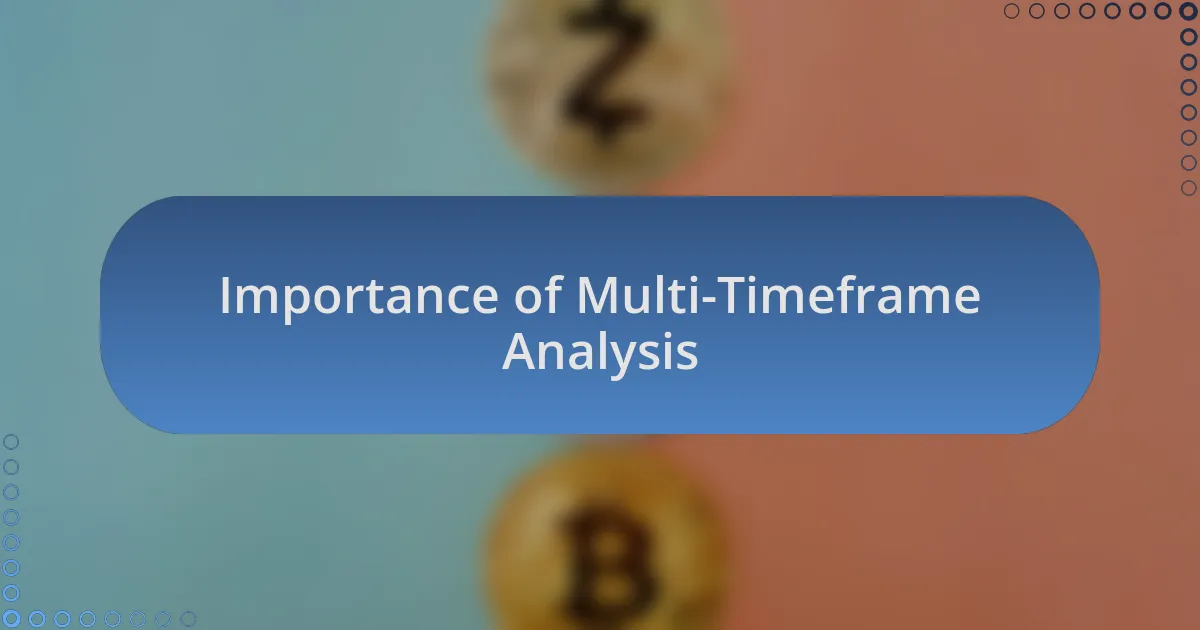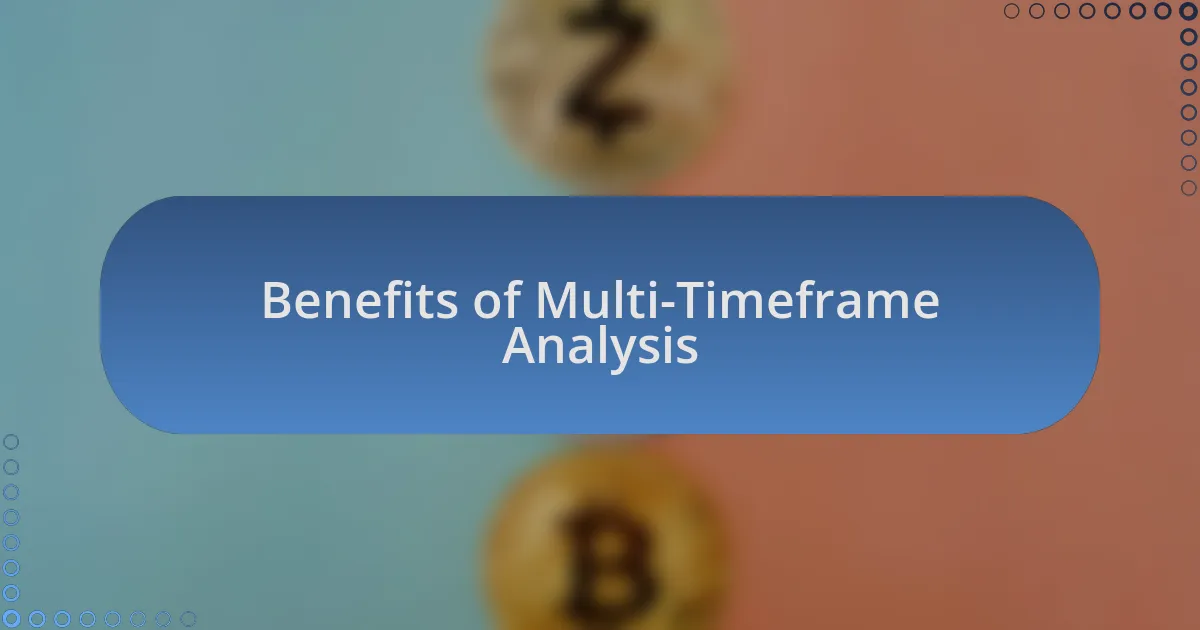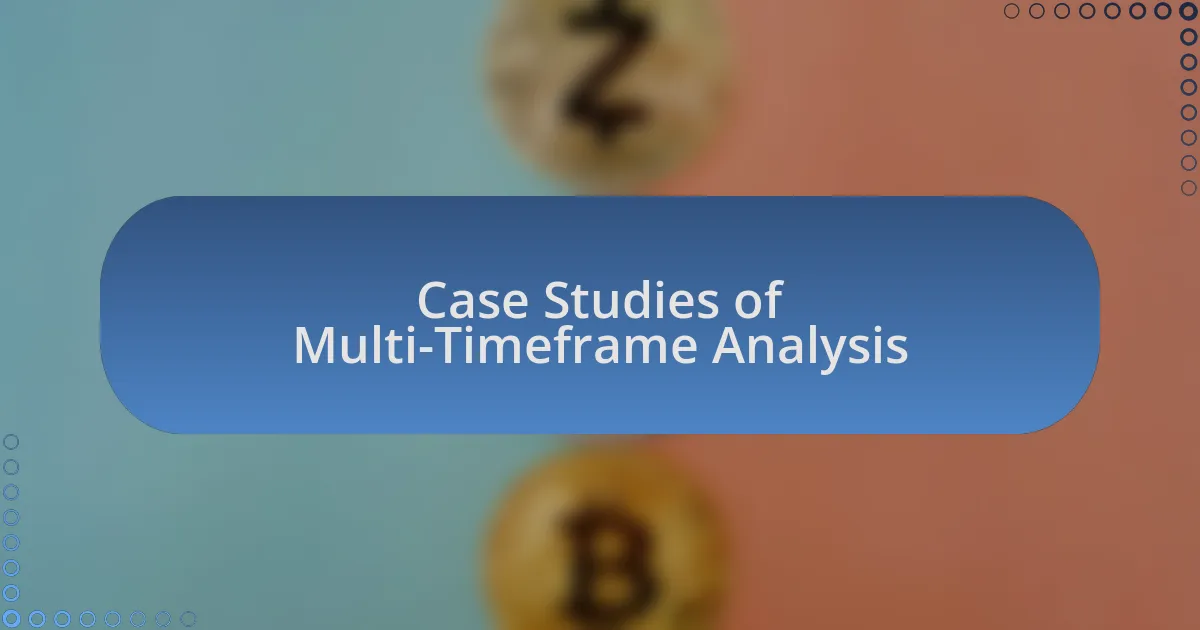Key takeaways:
- Multi-timeframe analysis (MTA) enhances trading decisions by providing a broader perspective on market trends, allowing traders to identify potential entry and exit points more effectively.
- MTA improves risk management and trading precision by revealing significant support and resistance levels that may not be visible on shorter timeframes.
- Utilizing tools like TradingView and alert systems can streamline MTA, facilitating timely decisions based on multiple timeframe analyses.
- Maintaining clarity of goals across different timeframes and controlling emotions during analysis are crucial for successful trading outcomes.

What is Multi-Timeframe Analysis
Multi-timeframe analysis (MTA) is a powerful trading tool that involves analyzing a financial asset’s performance across multiple timeframes. By looking at various periods—such as hourly, daily, and weekly charts—I can uncover trends and patterns that may not be visible when examining just one timeframe. This approach helps me identify potential entry and exit points more effectively, layering my understanding of the market.
In my experience, utilizing multiple timeframes can often lead to those “aha!” moments where everything clicks. Have you ever felt unsure about a trade? I remember staring at a one-hour chart, confused by the price action, only to switch to the daily chart and realize I was missing a larger bullish trend. This broader perspective can provide clarity and confidence, allowing me to make informed decisions rather than relying solely on short-term fluctuations.
What’s intriguing about MTA is how it creates a multi-dimensional view of the market. Each timeframe offers unique insights, and analyzing them together enhances my overall strategy. For instance, if I’m seeing a bullish signal on a daily chart while the hourly chart shows a temporary pullback, it reassures me that the long-term trend remains intact. Isn’t it fascinating how combining perspectives can strengthen our understanding of the crypto landscape?

Importance of Multi-Timeframe Analysis
Understanding the importance of multi-timeframe analysis (MTA) is crucial for effective trading. When I first started exploring MTA, I was surprised by how much more information I could gather by simply observing longer timeframes alongside shorter ones. It’s like looking through a pair of binoculars—without them, you miss out on valuable details that could significantly impact your decisions.
One specific time, I noticed a minor retracement on the 15-minute chart that made me anxious about a trade I was already in. However, when I flipped to the 4-hour chart, I saw that this pullback was just a natural part of a larger upward trend. That moment reinforced my belief in the significance of MTA; it’s like having a guiding compass in the chaotic seas of crypto trading.
Moreover, using multi-timeframe analysis helps me understand the market’s momentum better. I often find that trends form over different periods, and being aware of these can prevent me from making knee-jerk reactions to short-term movements. Have you ever acted impulsively, only to regret it later? Incorporating MTA into my strategy has definitely helped me stay grounded, keeping my focus on the bigger picture.

Benefits of Multi-Timeframe Analysis
Using multi-timeframe analysis not only enhances my understanding of market movements but also improves my trading precision. I remember a day when I was tempted to enter a trade based solely on a 1-hour chart signal. Thankfully, I took a moment to check the daily chart and realized that the overall trend was bearish. This critical insight saved me from what could have been a costly mistake and has since made me more disciplined in my approach.
Another significant benefit I’ve noticed is its impact on risk management. By analyzing different timeframes, I gain a better perspective on potential support and resistance levels. During a recent trading session, I identified a support level on the daily chart that wasn’t visible on the shorter timeframes. This allowed me to set my stop-loss more strategically, minimizing my risk while still enabling me to capitalize on the trade’s upside. Isn’t it reassuring to know that you can set yourself up for success with thoughtful analysis?
Lastly, engaging with multi-timeframe analysis fosters a broader view of the market context. I often find that it helps me align my trades with larger market movements, making my position feel more justified. For instance, spotting a bullish divergence on a weekly chart while confirming a buy signal on the hourly chart gives me the confidence to go in. In a landscape as volatile as crypto, isn’t it vital to build that confidence through a well-rounded analysis?

Tools for Multi-Timeframe Analysis
For effective multi-timeframe analysis, I rely on a combination of charting tools and indicators that offer clarity across various timeframes. One of my go-to platforms is TradingView, which allows me to view multiple charts simultaneously. The ability to overlay indicators like the Moving Average or Relative Strength Index (RSI) across daily, weekly, and intraday charts provides a more comprehensive understanding of market sentiment. Have you ever wished you had that kind of edge while trading?
Moreover, I find that utilizing alert systems significantly enhances my analysis process. For instance, setting alerts for specific price levels or indicator crosses on different timeframes ensures I don’t miss crucial market movements. Just last week, I received an alert notifying me of a breakout in a longer timeframe, prompting me to adjust my strategy on a shorter timeframe swiftly. Isn’t it a game changer when technology can keep you in the loop, allowing for timely and informed decisions?
Lastly, I often explore additional analytical tools like Fibonacci retracement levels and volume profile to complement my multi-timeframe insights. By applying Fibonacci levels on daily charts and assessing how they align with shorter-term price action, I enhance my ability to anticipate potential reversals or continuations. The feeling of combining these techniques can often lead to that “aha” moment in a trade setup. Have you ever experienced that thrill when everything just clicks? It’s moments like those that energize my trading journey.

My Strategy for Multi-Timeframe Analysis
When it comes to my strategy for multi-timeframe analysis, I start by establishing a clear hierarchy of timeframes. I typically use the daily chart for my overarching trend, then shift to the 4-hour and 1-hour charts to fine-tune my entry and exit points. This layered approach helps me avoid getting caught up in the noise of the market, allowing me to make more informed decisions.
One particular instance stands out in my mind when this strategy paid off handsomely. I noticed a bullish trend developing on the daily chart, but the 4-hour chart displayed some resistance. By patiently waiting for a bullish confirmation on the 1-hour chart, I managed to enter at a prime moment just before a nice rally. Have you ever felt that rush when your patience is rewarded with gains? It’s moments like these that make all the difference.
Additionally, I always incorporate volume analysis across these timeframes to validate my signals. During one trading session, I observed a spike in volume that coincided with a strong reversal on the daily chart, reinforcing my decision to enter a position. This intersection of data points—timeframes and volume—gives me a clearer picture and prompts me to double down on my conviction. It’s incredible how volume can tell a story that price action sometimes masks—do you look for similar signals in your trading?

Case Studies of Multi-Timeframe Analysis
One memorable case I experienced involved a potential breakout on a cryptocurrency I was monitoring. The daily chart showed a classic ascending triangle pattern, suggesting that momentum was building. When I shifted to the 4-hour chart, I noticed decreasing volume during the price consolidation, raising a flag for caution. Did I just dismiss the breakout? Absolutely not! I waited for a confirmed breakout on the 1-hour chart before entering, which ultimately led to a successful trade and reaffirmed my belief in the importance of multi-timeframe analysis.
Another instance that stands out happened when I was analyzing a highly volatile altcoin. The daily trend seemed bearish, yet the hourly chart painted a different tale with rapid price fluctuations. As I watched the 4-hour chart stabilize, I found myself torn—should I go long or short? It was a test of conviction. In this case, patience was my ally. By refusing to jump in too early and waiting for clarity across the timeframes, I ultimately capitalized on a rebound that did wonders for my overall portfolio.
In a separate scenario, I was tracking a major release that had the potential to sway market sentiment. Upon examining the daily chart, I noticed significant price resistance—yet the 4-hour chart revealed a potential reversal setup. This contradiction was invigorating and stressful! I narrowed my focus down to the 1-hour timeframe to pinpoint the optimal entry and exit point, resulting in a well-timed trade that caught the market’s subsequent surge. Have you ever felt that mixture of excitement and uncertainty when making a decision with varying signals? It reminds me how essential it is to draw insights from multiple perspectives in trading.

Tips for Effective Multi-Timeframe Analysis
When engaging in multi-timeframe analysis, start by clearly defining your goals for each timeframe. I’ve found it helpful to consider what I’m looking for—are there key levels, specific patterns, or general trends? This clarity guides my analysis and prevents me from getting lost in the noise of the charts. Have you ever entered a trade without a clear plan only to feel overwhelmed? A focused approach is essential in maintaining confidence during decision-making.
Another tip I consistently apply is to maintain a healthy balance between timeframes. For instance, while the weekly chart provides a broader market perspective, and the daily chart gives a clearer trend direction, the hourly chart is valuable for immediate entry points. I often think of it like tuning an instrument; each timeframe has its role in creating a harmonious trading strategy. Can you relate to that feeling when all the timeframes align perfectly? It’s exhilarating!
Additionally, I always make it a point to keep my emotions in check when analyzing multiple timeframes. It can be easy to get swept away by excitement or fear, especially when the markets are volatile. I remind myself to breathe and revisit the charts calmly. Have you ever made a knee-jerk decision during a price spike, only to regret it later? By taking a step back and assessing the situation from all angles, I find that patience pays off significantly in the long run.